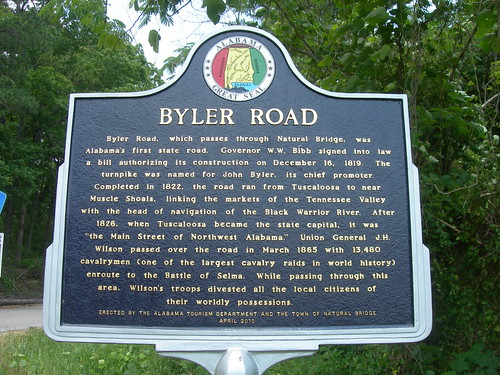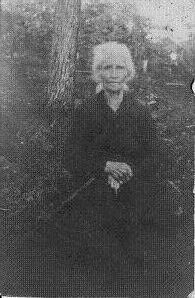Kinlock
On the western edge of the High Town Path in Lawrence County, an important mountain community was known as Kinlock. According to several early maps, Kinlock was located in the area of the present-day Macedonia Church near the junction of the Kinlock and Byler Roads in southwestern corner of Lawrence County, Alabama.


Kinlock Historic Marker
Since Kinlock Rock Shelter and Spring were approximately one mile southeast of the dividing ridge along which the High Town Path ran, the Kinlock sites were heavily used by both prehistoric and historic Indian people as well as early settlers. The Kinlock site provided early travelers of the northern portion of the Warrior Mountains a source of water and also shelter during severe weather. The Kinlock Shelter is a premier petroglyph site in the State of Alabama.

Kinlock Rock Shelter
According to Two Hundred Years at Muscle Shoals, “the first state highway provided for by the legislature meeting in Huntsville in 1819 was built through Bainbridge. It started from the Great Military Road on the west side of Shoal Creek in Lauderdale County, crossed the river at Bainbridge and passed south through Jeffers Cross Roads (Leighton) on through old LaGrange, Kinlock, Haleyville, Eldridge, Bankston to Tuscaloosa. While John Byler and his associates were authorized to build only a portion of the road south of Franklin County, the old turnpike, short sections of which are still in use, was known as Byler’s Turnpike Road. The road was directed to be twelve feet wide, clear of stumps and roots, and good causeways were planned for all soft places. The Byler Road was to facilitate travel from Nashville to Tuscaloosa, and, after the latter became the Capital of Alabama, in 1826, was a much used way, for many of our early settlers were from Tennessee and Virginia and used this route” (Leftwich, 1935).
The Old Buffalo Trail that became portions of the Byler Road and the High Town Path ran along the Continental Divide in the Kinlock portion of Bankhead Forest for some five miles. Both roads lay along the dividing ridges and east of the upper watershed of Bear Creek. The Byler Road turned south with the High Town Path traveling west along the Continental Divide south of Bear Creek to Flat Rock in Franklin County. The High Town Path became less important as river ferries and passage through Indian lands were obtained through treaties.


Byler Road Historic Marker
The Byler Road was built by John Byler and associates and was one of the first legislative acts of the State of Alabama. According to Lawrence County Deed Book C, pages 28 and 29, John Byler in March 1824 deeded Jacob Byler the undivided third part of the road known as Byler’s Turnpike Road.
The Kinlock area saw a great deal of action during the Civil War. Supposedly a detachment of Colonel Able Streight’s regiment was sent to Kinlock to take the grain and destroy the grist mill. Somewhere along or near the High Town Path portion, the Yankees of Northern Aggression were ambushed with the aid of the Cherokee family of Jane “Aunt Jenny” Bates Brooks Johnston, her family, and local settlers. Some accounts say that three to seven Yankees were killed in the ambush and were buried in the slave cemetery at Kinlock. Also during the Civil War, Aunt Jenny’s husband Willis and son John were taken and later killed by some soldiers that were members of the Home Guard and their bodies dumped in Denton Hollow in nearby Franklin County.


Jane "Aunt Jenny" Bates Brooks Johnston
1/2 Cherokee Indian
Later in the War of Northern Aggression during March 1865, General James Harrison Wilson organized the world’s largest cavalry of 13,480 horses at Gravely Springs in Lauderdale County. Wilson’s cavalrymen eventually engaged the Confederates at the Battle of Selma. One of the three divisions of the Wilson’s Civil War Cavalry rode along the High Town Path portion of the Byler Road to Kinlock. On March 24, 1865, Union General Edward Winslow with a portion of Major General James H. Wilson’s 14,000 men passed along the Poplar Springs area in route to Selma via Kinlock and Hubbard’s Mill. The Union division camped overnight at Hubbard’s Plantation around Kinlock Spring (Elliott, 1972).

General Edward Winslow
Major David Hubbard, who had a plantation home and mill near Kinlock Falls, was appointed Federal Commissioner of Indian Affairs of the Confederate States of America by President Jefferson Davis (Graves, 1985). Major Hubbard had a cotton factory on the High Town Path south of Bear Creek. According to an early Alabama map, Hubbard’s cotton factory was located west of his plantation home on the High Town Path. Hubbard’s home and grist mill were located at Kinlock Falls and Spring in Lawrence County’s southwest portion of Bankhead Forest.
During historic times, one of the most colorful Cherokee Indian ladies to ever settle in Bankhead Forest lived at Kinlock on the historic High Town Path and Byler Road. She went by the name of “Aunt Jenny” and many times she aided weary travelers of the High Town Path. Aunt Jenny deeded some of her Kinlock land for the location of Macedonia Church. All five of her sons and some of her grandsons were shot and killed. Aunt Jenny stated that her sons died with their boots on. She, along with some of her children, is buried in Poplar Springs Cemetery, just north of the Kinlock Community and a few yards west of the High Town Path.
Another Cherokee Indian lady of historic times whose family settled along the High Town Path in the Kinlock area was Mary Tennessee Garrison Spillers. Her son, Amos Spillers, who lived for awhile at Kinlock, became the first conservation officer of Bankhead National Forest and is buried in the forest at Mt. Olive Cemetery (Manasco, 1981). Many people who are descendants of Aunt Jenny and Mary Tennessee still live in north Alabama. Read more about early Indian paths and trails in the soon to be published book, Indian Trails of the Warrior Mountains and Southeast by Rickey Butch Walker and Lamar Marshall.
I grew up in Haleyville and i'm familiar with that area of the Bankhead. I love the Bankhead.
ReplyDelete